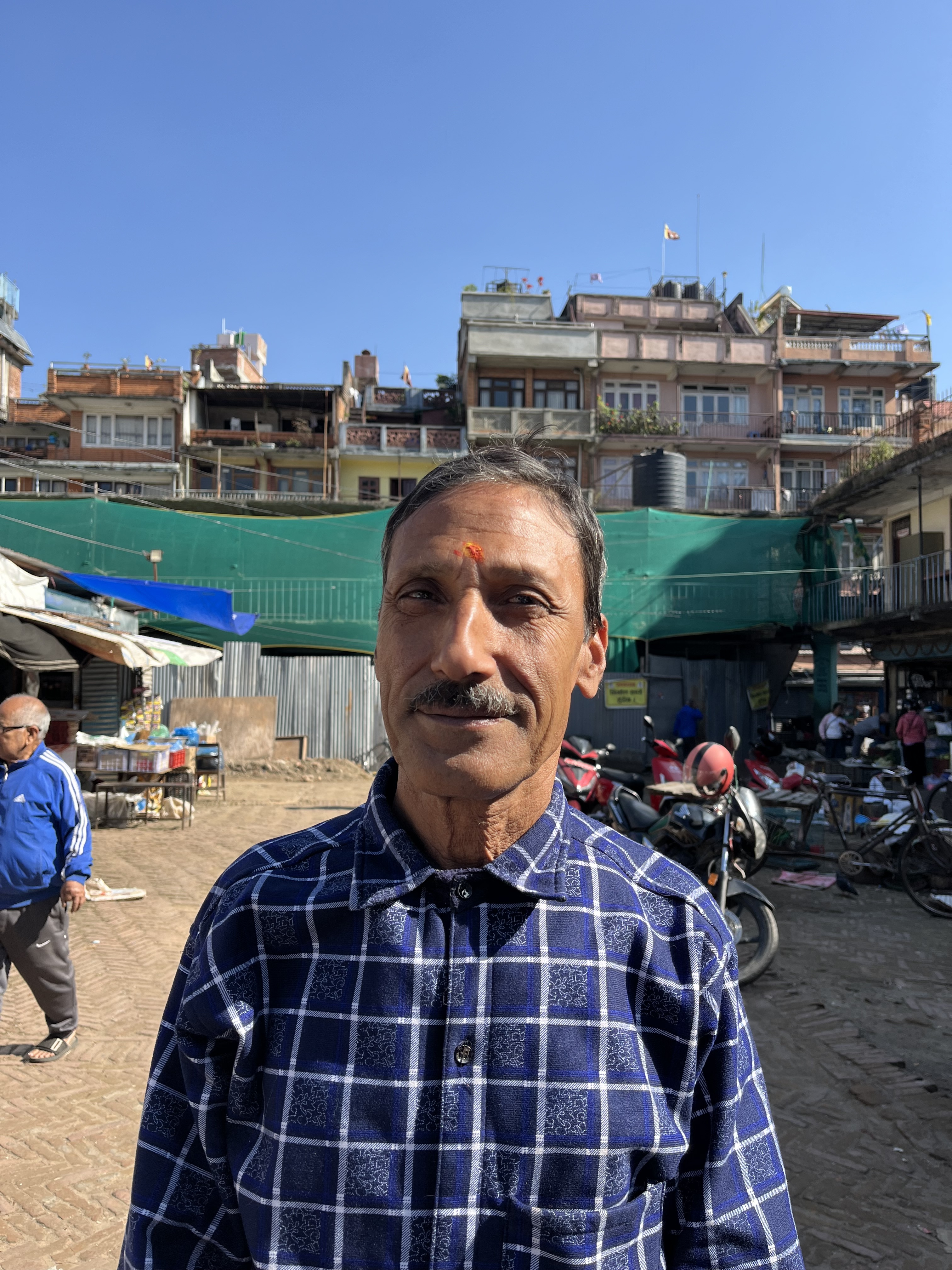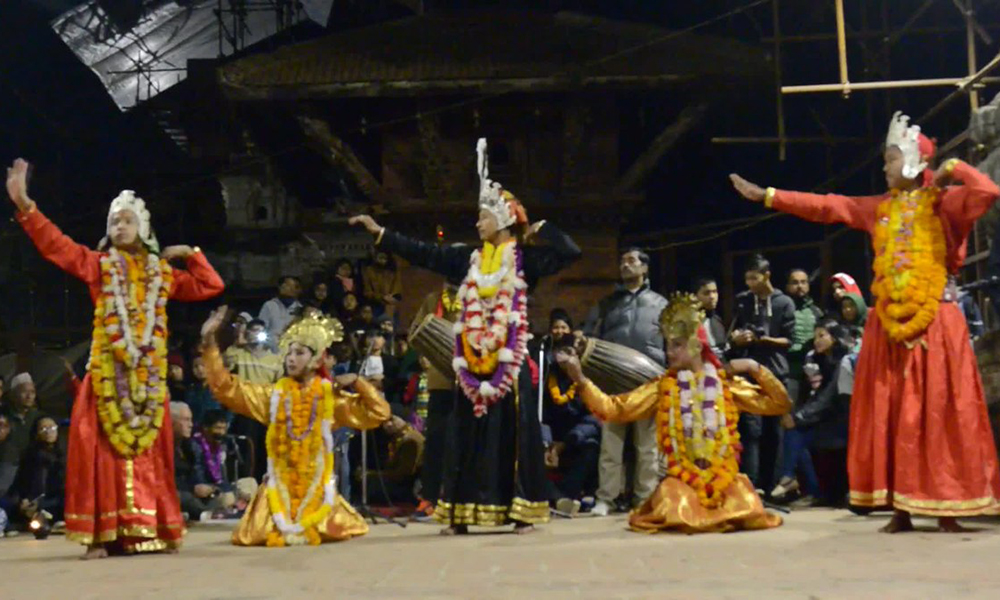12 rice
heaps shielding Patan from lightning

 Aashish Mishra
Aashish Mishra
Wed, 18 October 2023
Share
Lalitpur, Oct. 18: September 30, Saturday.
While Kathmandu was immersed in the merry of Indra Jatra,
neighbouring city Patan was busy preparing for a unique festival of its own –
the Punchali Bhuja.
The Bhuja is an annual ceremony for the worship of Goddess
Purnachandi, held in front of her temple, 260 metres southwest of Gabahal. It
is performed on the evening of the first day of the dark fortnight of the
Nepali month of Ashwin (Ashwin Krishna Paksha Pratipada) and eponymously
features a dozen heaps of Bhuja: boiled rice on circular plates.
Each heap is made of one Muri (160 pounds) of rice and
contains 84 different kinds of food items (Chaurasi Byanjan). They are moulded
in the shape of hills and are placed in front of the Purnachandi Temple on the
aforementioned day.
History
The origins of this festival are not clear. However, Bishnu Chandan Rajopadhyaya, a resident of the
Purnachandi area and a priest at the Taleju Temple in the Patan Durbar Square,
believed that it began during the Malla rule.
“Stories we heard growing up spoke of various calamities and
tragedies that befell Patan during the reign of a Malla king. He tried many
things to change the kingdom’s fortunes but to no avail. So ultimately, on the
advice of his Gurus, he began the Bhuja festival and the disasters stopped,” Rajopadhyaya shared.
This could be the case as, according to culture scholar and
researcher Dr. Nutandhar Sharma, the temple for Purnachandi was built in 1635
AD during the time of king Siddhi Narasingh Malla. “After some time though, a
fire burnt that structure down and the temple was reconstructed in the form we
see today,” Sharma, who is also a member of the faculty at the Aksheswar
Traditional Buddhist Art College, informed.
Purnachandi is an aniconic shrine (Peeth) revered as Goddess
Siddhilaxmi. She is also worshipped as the amalgamation of the energies
‘Shaktis’ of five deities-- Kali, Bhairavi, Bhagwati, Kumari and Laxmi. She is
also in the pantheon of the 10 Hindu Tantric goddesses collectively known as
the Das Mahavidya under the name Kamala – she originated from a lotus (Kamal)
flower and is the Tantric characterisation of Laxmi.
Meanwhile, the moniker Purnachandi, arguably the goddess’s
most famous appellation, signifies her consecration by the mystic Purnananda
Swami.
As Rajopadhyaya shared,
the Nekhu (Nakkhu) River once flowed through the place where the Purnachandi
Temple currently stands. One day, Goddess Dakshinkali from Pharping came
to visit. But, when she arrived, Purnananda recognised her and bound her in
place through magic. Since then, the goddess has lived in Lalitpur with the
name Purnachandi (Chandi established by Purna or Purnananda).
According to another version of the tale, Goddess
Siddhilaxmi appeared to Purnananda in a dream and asked him to come find her on
the bank of the Nekhu River. He did as told and followed the river’s course to
the present-day Purnachandi. There, he saw water bubbling out from the ground
and understood that that was where the goddess was. So, he worshipped there and
proclaimed it as the spot where Siddhilaxmi resided. Later, King Siddhi
Narasingh built a temple there.
Folktales may take imaginative liberties, but they have some
basis in reality. Here too, the presence of a stone cremation platform called
Bhakari or Tungal and a Yogeshwor Shiva Linga suggests that today’s Purnachandi
was once a Ghat near a flowing body of water. Perhaps, the pond that still
exists behind the temple is a remnant of that.
Steal of ‘62
Dr. Sharma mentioned that Purnachandi was a divinity of
great importance in Patan. “Almost half of Patan’s native population worships
the goddess as their guardian numen,” he said, adding, “She is also the
tutelary deity for the Rato Machhindranath.” Because of its status, the
Purnachandi Temple was endowed with much land and had several communal trusts
(Guthis) associated with it. This allowed it to fund its yearly rituals without
worry.
But then came the event infamous in Nepal’s cultural history
as the ‘Steal of ‘62’ (Basatthi Saalko Haran). In 1862 BS (1805 AD), the then
former King and sitting Head Executive Mukhtiyar Rana Bahadur Shah, who is
believed to have gone mad after the death of his favourite wife Kantiwati,
ordered the seizure of all lands provided to temples and religious orders.
“The government employee sent to confiscate Purnachandi’s
land was a local Amatya who himself worshipped her as his tutelary goddess,”
Sharma informed. “As it was a direct order from the very top, he took the land
but he was not happy."
He continued, “So, the Amatya pleaded with the king and
prevented its seizure by the state.”
“After this, he went to the priests of Purnachandi, who
belong to the Rajopadhyaya Brahmin caste
group, and offered them the land back. But, since he was the one who saved it,
the priests asked the Amatya to keep the land under his management.”
Since then, as the holders of the land, the Amatyas have
been an integral part of the Purnachandi Temple and the Punchali Bhuja rituals.
The Amatya who saved Purnachandi’s land was Raghubir Amatya,
who was a Subba, equivalent to a present-day non-gazetted officer in Nepal’s
bureaucracy, at the time. As per his fifth-generation descendant Raj Amatya,
Raghubir was able to successfully petition the palace and obtain a royal decree
in 1903 BS (1846 AD) to get Purnachandi’s land back.
“Between 1862 and 1903, the priests could only perform the
Punchali Bhuja ceremonies symbolically as the temple had no money. The festival
returned to its original form only after the return of the land.”
And for the past 120 years, the Amatya family have acted as
patrons for the Punchali Bhuja. Additionally, Raj informed that his family also
performed worship ceremonies every year on the establishment day of the
Purnachandi Temple and other special occasions.
Raj informed that the land they held for the temple was in
Khokana. He remembers receiving harvest from it till the 1980s.
Significance
As Rajopadhyaya put it,
the Punchali Bhuja is marked every year under the patronage of the Amatya
family, who manage the necessary items, and the officiation of the Rajopadhyaya priests, who carry out the religious
rites. Special tantric pujas are performed inside the temple and on its
premises, which last almost the whole Pratipada night, and involve animal
sacrifice and a special oblation called Kushakandika. The oblation is believed
to both satisfy and strengthen the gods.
The most visible parts of the ceremony are the 12 white
Bhujas placed just in front of the temple’s entrance. The Purnachandi Jatra,
where the goddess is taken around various locations in Patan, also begins on
Pratipada day.
But why is the Punchali Bhuja performed? “It shields Patan
from lightning,” Rajopadhyaya, Sharma and
Raj shared. “The Bhuja is one of a few specific ‘Mala’ (lightning) worships
performed in Patan to prevent thunderbolt strikes,” Rajopadhyaya
said.
“There does seem to be something to this belief as we do not
see many lightning strikes within the borders of the old Patan city,” Dr.
Sharma remarked.




.jpg)
.jpg)





















